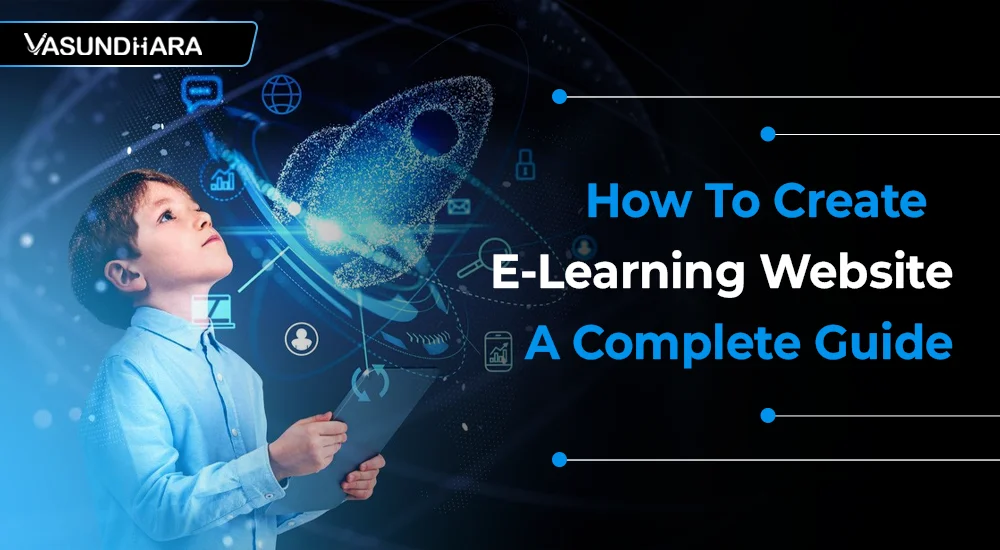How To Create E-Learning Website: A Complete Guide


- Jul 11, 2024
The eLearning industry has experienced exponential growth in recent years, becoming a key component of modern education. Building an eLearning website can be an advantageous venture whether you’re an educational institution, a corporate training provider, or an entrepreneur. This comprehensive guide will take you through each step of the process, from initial planning to launch and beyond.
E-learning platforms have proven to be more effective than the old educational system. Despite the fact that the Internet has provided us with a wealth of dubious information, there is a way out. In this regard, if you've ever considered an educational IT project, it's about time to construct an e-learning website. It will be a credible source of information, with a smart study schedule to facilitate optimal learning processes. This latest blog by Vasundhara Infotech covers everything you need to know about e-leaning custom website development and how to create e-learning website.
E-learning Websites unlock the potential for remote education. Individuals of all ages desire to remain informed about the ever-changing environment and prevent their essential skills from becoming obsolete.
The worldwide e-learning audience is expanding with the growing number of smartphone consumers, with a 4.2% annual increase. The convenience of mobile phone usage motivates individuals to study; 70% report feeling more motivated. An additional illustration is the implementation of 5G technology at high speeds, contributing to the e-learning market's expansion.
In simple terms, e-learning (also known as online learning) refers to electronic learning, which encompasses any form of learning that is conducted through digital devices. For example, e-learning is the utilization of desktops, laptops, mobile phones, tablets, or any other device for the purpose of online education and learning.
E-learning online platforms are self-paced, accessible to all, offer a variety of learning techniques, provide access to a wider range of individuals and data, eradicate geographical constraints, and are frequently cost-effective. Udemy and Coursera are the most successful and prominent examples of an e-learning portal.
We should first comprehend the rationale behind the development of an e-learning website before proceeding to the tutorial on how to construct one. E-learning facilitates transformation for all individuals. Whether you are a student, an employee, a content creator, or a teacher.
Additionally, your e-learning website provides you with the capacity to integrate all of these segments. Europe is poised to capitalize on the virtual learning environment. In 2019, Europe accounted for 35% of the market share and continues to expand.
The following are several significant factors in e-learning platform development:
Let's investigate the advantages that come with having a website that is successful in e-learning.
An e-learning website enables a learner to study more conveniently, instead of being restricted to a classroom, city, or country. Thus, developing an e-learning website can offer your platform users unparalleled adaptability by enabling them to learn from various locations.
E-learning websites enable users to access them from any location, motivating them to learn and study.
In contrast to conventional learning methods, an e-learning website is highly cost-effective. Entrepreneurs can reduce their expenses by eliminating the need to pay salaries to their employees, rent for classrooms, and other similar expenses. Additionally, it reduces publishing expenses by ensuring that the study materials are accessible online and can be updated quickly and easily.
Furthermore, it reduces the cost of travel and accommodation by eliminating the need to travel between cities.
Another significant advantage of an e-learning website is the broadening of educational opportunities to a vast audience. By establishing an e-learning website, you can easily connect to many learners, as they can easily access your platform with and internet connection.
Consequently, individuals can acquire knowledge like that of websites such as Udemy, Coursera, Edx, and others, irrespective of their location. In order to leverage the website development services and provide your audience with the exceptional functionalities of the e-learning website, it is possible to collaborate with a competent development partner.
Also read: How To Implement Gamification in Education
In order to proceed with developing an e-learning web application or website, we will examine the construction process.
Developing an eLearning website is a multifaceted process that necessitates meticulous planning, design, and development to guarantee a seamless user experience. The following is a comprehensive instruction to each step:
Thorough planning and research are the initial steps in developing an eLearning website. Identify your target audience and gain insight into their learning preferences and requirements. Define the primary goals of your website, including corporate training, K-12 education, postsecondary education, and professional development.
Analyze the offerings of other eLearning platforms and identify any voids that can be addressed by conducting a competitive analysis. Determine the courses you will provide, the format (e.g., interactive modules, exams, videos), and any certifications or credentials you may offer.
The success of your eLearning website is contingent upon the selection of the appropriate platform. You have the option of selecting a pre-built Learning Management System (LMS) such as Moodle, Blackboard, or Canvas, which offers a variety of built-in features and functionalities, or you can construct a custom solution from the ground up.
A custom-built platform is more adaptable and can be customized to meet specific needs; however, it necessitates additional time and resources. Assess the advantages and disadvantages of each alternative in accordance with your technical proficiency, budget, and requirements.
Also read: How Gamification is Transforming the Education Industry
The primary objective of the design phase is to develop a user experience (UX) that is both engaging and intuitive. Begin by creating wireframes and prototypes to establish the website's structure and layout. Ensure that the navigation is user-friendly and that the courses they require are readily accessible.
The design should be responsive to ensure compatibility with a variety of devices, including desktops, iPads, and smartphones. Pay particular attention to the visual design, integrating your brand's colors, logos, and overall aesthetic to establish a unified appearance and feel.
The development phase commences once the design is established. This entails the development of the website's front-end and back-end. Front-end development is concerned with the visual and interactive elements that users encounter, utilizing technologies such as JavaScript, CSS, and HTML.
Back-end development entails the use of server-side programming and database administration, utilizing languages such as PHP, Python, or Ruby, and databases like MongoDB or the MySQL database. This phase also encompasses the integration of third-party services, including email marketing tools, payment gateways, and analytics platforms.
Content is the heart of any eLearning platform. Develop high-quality educational materials that are engaging and informative. This may include video lectures, interactive quizzes, downloadable resources, and discussion forums. Use a variety of media formats to cater to different learning styles.
Once the content is ready, upload it to your LMS or custom-built platform. Ensure that the content is well-organized, easy to navigate, and accessible to all users, including those with disabilities.
User management is essential for handling registrations, enrollments, and user profiles. Implement a robust user authentication system to ensure that only authorized users can access the content. Consider adding features like single sign-on (SSO), role-based access control, and secure password storage. Security measures should also include data encryption, secure payment processing, and regular security audits to protect user data and prevent breaches.
Before launching your eLearning website, conduct thorough testing to identify and fix any bugs or issues. Perform usability testing to ensure that the website is user-friendly and meets the needs of your target audience. Test the website’s performance under different conditions, such as high traffic loads and various device types.
Quality assurance (QA) should also include checking for content accuracy, ensuring that all links and media files work correctly, and verifying that the website meets all relevant accessibility standards.
Once testing is complete and any necessary adjustments have been made, it’s time to launch your eLearning website. Develop a marketing strategy to promote your platform, which may include social media marketing, search engine optimization (SEO), email campaigns, and partnerships with educational institutions or industry influencers. Provide users with tutorials and support resources to help them get started with your platform.
Creating a custom eLearning platform is a challenging yet rewarding objective, provided that it is executed correctly. This guide delineated the process of developing a customized online learning solution.
Although you currently possess a comprehensive development roadmap, the process of constructing a substantial platform presents numerous obstacles. If the technical aspects appear to be overwhelming, consider utilizing the services of eLearning specialists.
At Vasundhara Infotech, we offer comprehensive guidance, from developing concepts to delivering a custom website development solution. By leveraging our team's extensive experience in developing award-winning eLearning products, you can create a solution that is ready for implementation.
To transform your online education vision into a technical success story with expert support, request for a FREE quote today for a complimentary consultation.
Building an eLearning website involves careful planning, execution, and continuous improvement. By focusing on quality content, user experience, and effective marketing strategies, you can create a successful eLearning platform that meets the educational needs of learners worldwide.
As a leading website development company in India, Vasundhara Infotech specializes in developing cutting-edge eLearning platforms tailored to your specific needs. With our expertise in custom website development and a deep understanding of the eLearning industry, we can help you create a powerful and engaging online education platform.
Contact us today to get started on your eLearning journey!
Copyright © 2025 Vasundhara Infotech. All Rights Reserved.
